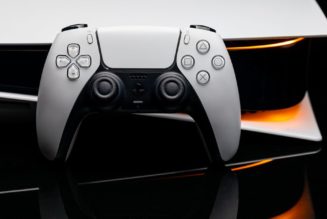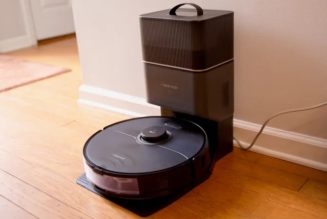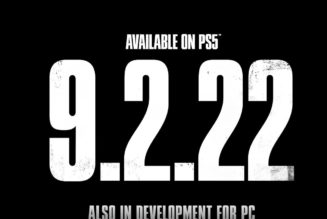I’m making a note here: huge success.
Share this story
:format(webp)/cdn.vox-cdn.com/uploads/chorus_asset/file/23270003/vpavic_220210_5030_0054_Edit.jpg)
The Steam Deck is my favorite gadget of 2022. I have no hesitation in recommending it anymore. The kind of person who would buy one should buy one. My only question: are you that kind of person?
In February of last year, I truthfully wrote that the Steam Deck wasn’t ready, and I stand by every word of that review. But it’s ready now. And while it’s still not finished, and may never be finished, Valve has spent nearly a year and over 100 updates showing that an early access game console can actually be worth money. Valve has finally succeeded in proving doubters wrong about Linux, creating a gadget that’s spent 35 weeks atop the Steam bestseller list and attracted support from Sony, Microsoft and more. In my eyes, this was a triumph: a dark horse that will shape the gaming landscape for years to come.
:format(webp)/cdn.vox-cdn.com/uploads/chorus_asset/file/23270010/vpavic_220210_5030_0090.jpg)
Practically, this handheld gaming PC will never be a Nintendo Switch or PlayStation Vita. You’ll never know for sure that a game will work and keep on working before you spend your cash. But if you’re the kind of person who was frustrated by the Vita’s missed potential, who wishes the Switch were more powerful, or who simply wants to burn through your backlog of PC games, the Deck delivers at an unbeatable price. It’s quite possibly the most powerful gaming device ever sold for $400, with roughly the power of a PS4 under its 7-inch screen.
I should know. I’ve now spent 435 hours playing Steam games across three different Decks, averaging well over an hour per day since launch. I’ve torn through all 150 hours of Elden Ring and beat Stray, Cult of the Lamb, Signalis, The Forgotten City, Into the Breach, and Vampire Survivors* on the Deck alone. I’m in the middle of dozens more. Plus, those 435 hours don’t count all the time I’ve spent futzing around with alternative games stores, emulators, streaming games from PS5 to the handheld, or cracking open the case to install a better fan and a larger SSD.
And what I’ve noticed, having made the Steam Deck my daily driver for gaming, is that my complaints have largely melted away. Valve has delivered so many fixes that, for the most part, I can just play. It’s been a minute since I’ve had the games on an SD card disappear, waited hours for a game to update, or had Bluetooth or Wi-Fi suddenly vanish until I give the Deck a good kick in the pants.
And while I’m still not completely satisfied with the Steam Deck’s fan, it’s no longer a constant annoyance. Valve has adjusted the fan curve, added an “engineered foam solution to reduce fan noise,” and shipped replacement fans to iFixit that you can easily buy and install to reduce whine.
As of today, here is my whittled-down list of complaints:
- Battery life can be short, and it takes a long time to charge.
- The rear paddles are still stiff.
- The bumpers are still awkward to reach compared to my Xbox or PlayStation pads.
- You still can’t download games without leaving the screen on.
- The one I bought for myself had some backlight bleed — and so does its replacement.
- The screen could be bigger. It’s got a lot of unnecessary bezel.
- I still see random game crashes, system reboots, and black screens maybe twice a month.
- Rarely, I’ve had the Deck’s controls quit working in the middle of a game, usually after resuming from sleep.
- Bluetooth audio lag still sucks.
- There’s no support for microphones over Bluetooth.
- I still occasionally get errors trying to transfer games between SD and internal storage.
- The fan keeps kicking on and off in very low-power games.
- Summoning the touchscreen keyboard is still sluggish, and I wish I could use my voice.
- Even on Valve’s “stable” update ring, there are still occasionally weird issues, like how my Deck abruptly lost power a couple times in November.
- Duck Game, the game I play most with friends, mysteriously starts dropping frames after maybe a half-hour of rock-solid 60fps.
- Valve’s listings of which games do and don’t work aren’t wholly reliable.
Does that sound like a lot? I could have come up with a similar, if smaller, list for the original Nintendo Switch. But a surprising amount has been fixed — and incredibly, Valve keeps adding new features that make the Deck even better.
Last February, the Steam Deck wasn’t just a buggy mess — it was also an unproven handheld that simply wouldn’t run a lot of your favorite games and one that forced you to choose between battery life and smooth graphics in moderately intensive titles. It was a system you’d wait months to buy, with an uncertain future. All of that has changed.
:format(webp)/cdn.vox-cdn.com/uploads/chorus_asset/file/23270006/vpavic_220210_5030_0079.jpg)
In my original review, I told you how I couldn’t play some of the biggest games my friends were enjoying and talking about, including Back 4 Blood, Cyberpunk 2077, Duck Game, GTA V, Halo Infinite, and Persona 4 Golden. They all work today. So do many games my friends have adopted since, like Among Us, V Rising, Monster Hunter Rise, Sonic & All-Stars Racing Transformed, and Earth Defense Force 5. When it’s lights out and I’m waiting for my kids to fall asleep, the Deck often keeps me from missing a virtual playdate.
These days, I’m even finding even “unsupported” games will often run, like my copies of Brothers: A Tale of Two Sons, Chip’s Challenge, Frozen Synapse, the original Half-Life, Metal Slug 3, Spec Ops: The Line, Stalker: Shadow of Chernobyl, The Witcher 2, Trails in the Sky, and XCOM: Enemy Within. The graphical glitches I saw in Jedi Knight and Max Payne 3 are gone — though now the original Max Payne’s comic book cutscenes fail to load, unfortunately.
Frankly, it’s a little weird owning a system where games can flicker in and out of existence — like most of Electronic Arts’ most popular PC games did when the company added a new launcher that wasn’t compatible with the Deck. But the overarching trend is that more and more games work, most of them as well as they would on a similar Windows PC.
:format(webp)/cdn.vox-cdn.com/uploads/chorus_asset/file/24354176/elden_ring_1.jpg)
The big exception is multiplayer games with anti-cheat software, including some of the biggest titles in the world. Fortnite, PUBG, Lost Ark, CoD: Warzone, Rust, Destiny 2, Rainbow Six Siege, DayZ, Dead by Daylight, Hunt: Showdown and Naraka: Bladepoint are missing in action, to name just a few. Bungie and Epic have explicitly rejected the Deck for Destiny 2 and Fortnite, and there’s been no sign they’ll change their tune.
It’s a shame, but I’ve also found I don’t miss those multiplayer shooters and slicers all that much on the Deck. Battle royale games beg for a large, high-refresh-rate screen so you can spot enemies at a distance; when Apex Legends came to the Deck, I quit pretty fast because I was tired of never knowing what hit me.
Where the Deck really excels is blazing through your gaming backlog, partly thanks to the Proton developers that Valve is paying to build compatibility around practically every game on Steam, and — incredibly — thanks to Sony and Microsoft, too.
I don’t think I’m exaggerating when I say Sony’s publishing studios are supporting the Steam Deck more than they supported the PlayStation Vita, and I don’t just mean in terms of carrying the portable indie gaming torch. As my colleague Jay Peters has written, the Steam Deck is making PlayStation’s biggest games portable. Deathloop, God of War, Horizon Zero Dawn, Days Gone, Death Stranding, Final Fantasy VII Remake Intergrade, Spider-Man Remastered, Spider-Man: Miles Morales, the Uncharted: Legacy of Thieves Collection, and Sackboy: A Big Adventure have all come to Deck. The Last of Us Part I will join them in March.
:format(webp)/cdn.vox-cdn.com/uploads/chorus_asset/file/23933976/download__1_.jpeg)
The Persona games, once exclusive to PlayStation, are wonderful on the Deck as well, including Persona 5 Royal and Persona 4 Golden. Persona 3 Portable just came to Steam today. Many of Sega’s other former PlayStation-exclusive titles are Deck Verified, too, including half the Yakuza games, spinoffs Judgment and Lost Judgment (the latter did launch on Xbox simultaneously) and both the mainline Valkyria Chronicles titles.
And if you have a PS5, PS4 or PS4 Pro, you have to check out the Chiaki app — it lets you sling games from your actual PlayStation to Linux across your home network. It’s an open-source client for Sony’s PS Remote Play, and there’s even a new fork designed especially for the Deck that’s added DualSense support. Me, I enjoy using the Steam Deck’s own controls so I can easily add gyro aiming to my PlayStation games.
Microsoft, meanwhile, put in the effort to make sure Xbox Cloud Gaming works on Steam Deck — giving you access to many Xbox Game Pass titles if you’re an Ultimate subscriber — and is working with Valve to make sure games like Forza Horizon 5, Halo Infinite, and Halo: The Master Chief Collection play their best on the Deck, too. While Valve tells us Halo MCC multiplayer may take a while longer, I’ll soon be playing Halo: Reach, a game I never experienced on Xbox, because single-player already works.
:format(webp)/cdn.vox-cdn.com/uploads/chorus_asset/file/24354164/226464_Steam_Deck_is_fun_AKrales_0105_crop.jpg)
Of course, Steam and the cloud aren’t the only ways to get your games on the Deck. The handheld’s Linux desktop, which you can easily access by long-pressing the power button, opens up many more. The built-in Discover app catalog includes apps that can install your Epic Games Store and GOG game libraries (Heroic, Lutris), an incredible collection of emulators, including perhaps the best way to play Metroid Prime, the Chiaki app I mentioned, plus original Linux freeware games.
You can even find a reverse-engineered copy of Space Cadet Pinball, the classic Windows 95 timewaster, and — though they’ve requested that I don’t say where — someone even built a Linux launcher for Genshin Impact that makes it playable on the Deck.
a:hover]:shadow-highlight-franklin [&>a]:shadow-underline-black dark:[&>a:hover]:shadow-highlight-franklin dark:[&>a]:shadow-underline-white md:text-30″>Enhanced capabilities
The reason to buy a Steam Deck isn’t to play the same games you could play on Windows the same way, though. Like I laid out in my original review, it’s about having a portable gaming PC that actually makes sense on the go — one that can instantly suspend games like a Nintendo Switch while giving you decades’ worth of PC games and the controls you need to play them handheld.
Even at launch, I was wowed by how the Steam Deck’s open-source MangoHud overlay and Gamescope gave me instant feedback on how games were running, how quickly the battery was draining, and a realistic estimate of how long the Deck would last. I could lock the frame rate to 30fps to nearly double my battery life in some games, too.
But last spring, Valve found a smart way to get more performance out of the Deck as well — by letting you refresh its screen at 40Hz instead of 60Hz and adjust the framerate limit accordingly. Suddenly, games that couldn’t quite run at a smooth 60fps were no longer instantly limited to a pokey 30fps: you could run them at 40fps for way smoother gameplay. (As Digital Foundry explains, 40Hz is actually halfway between 30Hz and 60Hz in smoothness if you do the frame persistence math.)
Suddenly, games like Deathloop felt playable to me, and my ability to tackle Elden Ring bosses got a big boost in indoor environs where the Deck can consistently hit that 40fps. And Valve didn’t leave it at that — you can now save per-game performance profiles, uncap your frame rate, allow screen tearing, and see your frame rate, battery life, and temperatures in a new horizontal performance overlay that uses the wasted space when you’re running games at 16:9.
The other thing that makes games like Deathloop feel playable on a 7-inch PC: the Steam Deck’s unprecedented ability to make its touchpads, joysticks, triggers, buttons, and paddles do practically anything you’d like. In February, I called it a “dizzying” array of options — twice! — but I enjoy it even more today than I did during my original review.
In fact, let’s use Deathloop as an example. At launch, I was frustrated with how sluggish the gamepad felt in that snazzy time-traveling shooter — particularly because the game also doesn’t let you mix controller and mouse / keyboard inputs. My options were A) cobble together an entirely new control scheme around mouse and keyboard emulation or B) play with gamepad controls that felt like crap.
But when I revisited the game in December, I found another Steam Deck user had done 95 percent of the work for me. They’d uploaded a custom control scheme that felt amazing with gyro aiming, paddles to quickly lean and dodge (helpful for Juliana invasions), plus a right-touchpad mouse cursor to easily navigate menus. And then, I realized I could add one little tweak that’d finally make Deathloop’s weapon switching make sense: I told my Deck that whenever I double-tap the left or right bumpers, it should switch the weapons or gadgets in my left and right hands.
:format(webp)/cdn.vox-cdn.com/uploads/chorus_asset/file/24354177/vampire_survivors_1.jpg)
There are layers upon layers of options like this that I’m beginning to add to my games. A single button can do one thing when you press it, another when you release it, another when you long-press, another when you double-tap, and more — each with haptic feedback. Any button can be a Turbo button, repeating a command as quickly or slowly as you want: I now use them to quack incessantly in Duck Game, blow away EDF aliens with bursts of semi-automatic fire, and quickly advance text in RPG games that have a lot of dialogue. And in single-stick games like Brotato and Vampire Survivors, I’ll make the right analog stick mirror the left one so I can give my thumb a rest.
The Deck’s UI has improved, too. It’s easy for me to forget you couldn’t launch multiple apps during the review period, let alone switch between multiple windows — now, I can chat in Discord or stream music while playing a game, or virtually Alt-Tab between my Dolphin emulator settings windows without switching to the Linux desktop. And while the interface is nowhere near iPhone smooth, it’s certainly far snappier than it was at launch. The Plasma desktop environment, in particular, is way more responsive as of a late December update.
Adaptive brightness also now works in gaming mode (though I prefer Quick Access + Left Joystick to set it manually), and there’s a dual-touchpad swipe and tap virtual keyboard I vastly prefer to the hunt-and-peck one that originally shipped. Valve’s also spent time working on the offline mode, refinements when docking to a TV, additional controller support — and you can finally use the Deck’s limitless controller configurations when streaming games from your desktop PC, too.
You can also set a lock screen PIN for your Steam Deck and add awesome 30-second custom boot videos, unmount your SD card, and… you probably don’t want to hear about every little UI change, right? You can scroll through this website for Valve’s complete changelog.
a:hover]:shadow-highlight-franklin [&>a]:shadow-underline-black dark:[&>a:hover]:shadow-highlight-franklin dark:[&>a]:shadow-underline-white md:text-30″>The ecosystem
But one of the reasons I feel comfortable recommending the Steam Deck now isn’t just because of Valve — it’s how software and hardware communities have embraced the Deck, likely giving it a longer life than other gaming handhelds.
Yes, I mentioned Sony and Microsoft, but I’m also talking about the fans building custom plug-ins for the Deck that extend its capabilities, including a set of “PowerTools” that let you disable CPU threads and adjust clock speed to stabilize performance in some emulators and games. Or this website dedicated to fan-made boot and suspend videos your Deck can play whenever you press the power button or custom art for your game library.
I’m talking about the fans who built labors of love like EmuDeck to automatically install and configure all those emulators for the Deck’s controls without you lifting a finger, who are optimizing their emulators for Deck, turning it into an internet-connected television, and bringing Linux apps like the Heroic Game Launcher to Flathub so Linux n00bs like me can easily transfer our pile of free Epic Games Store games. (I still need to try BoilR, too.) Even Windows is getting better on the Deck, thanks to efforts like ayufan’s Steam Deck Tools.
And I’m talking about the 3D printing enthusiasts who’ve come up with accessories for the Deck that are good enough to sell, like the RestDeck and DeckMate accessory ecosystem — heck, DeckMate will even let you download the files for free.
I’m even talking about established companies like JSAUX, Dbrand, and, above all, iFixit, who’ve decided that serving the Steam Deck community is good for business. iFixit is now selling practically every part of the Steam Deck (now including the battery) to anyone who wants to repair it themselves, with Valve’s blessing and support. JSAUX was an alphabet-soup-name Chinese company that’s developing into an actual brand name because it was the first to seriously serve Steam Deck customers with bespoke accessories. Dbrand decided its reputation among the Steam Deck community was important enough to do a million-dollar recall of its hardshell kickstand case.
Heck, you can even buy drift-resistant Hall Effect sensor joysticks for your Steam Deck now.
:format(webp)/cdn.vox-cdn.com/uploads/chorus_asset/file/24059226/DSC_0261.jpg)
In hindsight, the only thing I regret about my original Steam Deck review is I might have discouraged you from being a part of this community early on. If you’re just buying one now, you might have missed part of the ride.
But in my defense, there was no way for me to know things would turn out this well, especially given how rough the Steam Deck was when it first arrived. Plus, it wasn’t like you could just up and buy one. It took nearly eight months for Valve to get through the waitlist, and the Steam Deck has gotten better with each month that’s gone by.
According to data harvested from Valve’s servers, the Deck has already accounted for one-third of my total Steam playtime since 2019. It’s changed how I play games and where I buy them, just the way I’d hoped it would during my first hands-on last year. Now, instead of buying games for the Nintendo Switch, I’m paying for PC copies again. I know I’m not the only one.
No other company has yet delivered this combination of portability, performance, and price. I’m waiting and watching for that to change because we all know that technology marches on, Valve seems happy to let others borrow its know-how, and it intends to (eventually) offer a sequel that’ll likely have more battery life and a better screen.
But as of today, nearly 11 months after the first units started shipping, the Steam Deck feels like an excellent deal.
It’s enough that we’ve decided to increase our review score to a 7, which is a bigger jump than it seems. Last August, we decided to begin using the whole 10-point scale; under the new rubric, we would have given the original Steam Deck a 4 or a 5 instead of the 6.5 we did originally. We describe a 7 as “Very good. A solid product with some flaws,” which nicely describes how I feel about my own Steam Deck today.
Steam Deck: one frequently asked question
If you decide to buy a Deck and you’re not sure which, the answer is yes — you really can just buy the $400 64GB version. I used the $400 and $650 models interchangeably for months and couldn’t find any meaningful performance difference playing games on SD card vs. SSD. I actually slightly prefer the $400 model’s glossy screen, whose colors come through more clearly, though it’s definitely faster to download and install games to an internal NVMe drive. But if that’s a must, it’s also cheap and easy to swap in your own SSD — it’s just one more screw than it takes to replace the fan.









